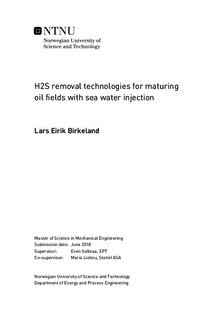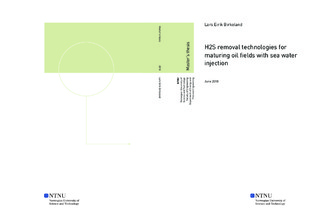| dc.description.abstract | Enhanced oil and gas recovery is often performed with seawater injection in the well as pressure compensating mean. With it, potential challenges arise. Microbiological souring is considered a major contributor to the increased mass of H_2 S found in the produced hydrocarbon fluids. Seawater is often rich in electron acceptors (sulphate/thiosulphate), which are normally found in short supply downstream reservoir. These electron acceptors are easily reduced by sulphate reducing bacteria (SRB) to sulphide (S2-) and then the generation of H_2 S is initiated. The origin, growth and survival of SRB are studied.
For typical NCS conditions, with low concentrations of H_2 S, scavenger chemical injection or solid bed adsorption is usually installed to remove the toxic and corrosive gas. Regenerative amine plant is mostly applied for large volume, low acid gas partial pressure hydrocarbon streams. For bulk removal of larger amounts of H_2 S, regenerative physical solvent or membrane technology are usually selected based on the generally higher absorption capacity for such processes.
A typical three stage offshore separation and stabilization plant is designed with focus on two H_2 S sweetening technologies; scavenger injection and amine plant.
A real fluid composition and production profiles as well as H_2 S production profiles for future years are known and will be the basis for the simulation. The reservoir is simulated by mixing the multiphase hydrocarbon stream, the injected seawater, H_2 S and a returned amount of processed oil and gas.
An estimation of the scavenger consumption and costs have been performed based on approximately numbers for scavenger chemical cost per liter and scavenger absorption capacity. Estimations of sizes, weight, power consumption and cost (high uncertainty) for the amine plant is done based on numbers from Hysys.
Different injection points or a combination of two injection points in the separation plant have been simulated. Injection after first stage compression was found to be cheapest but is vulnerable towards corrosion. With only a minor increase in chemical cost and a significant reduction in corrosion potential, injection after first separator and mixer (gas from 2. and 3. oil separator) may be a better solution. Subsea injection was observed to have a dramatic increase in chemical cost but may be necessary for old facilities without sour service installation, which is typically a result of the originally sweet reservoir.
The validation of the Hysys model proved that a significant uncertainty for the H_2 S distribution must be expected, and we will probably find a considerable lower H_2 S concentration in the gas phase for real scenario operations.
Scavenger technology seems to be the preferred process based on many factors including simplicity and flexibility, a high potential for a large footprint and CAPEX related with amine installation, generally more suited for this particular gas rate and H_2 S level observed, the validation of the Hysys model and a yearly reboiler (amine) electricity cost that is possibly not far from the yearly scavenger cost (cheapest option). | en |

